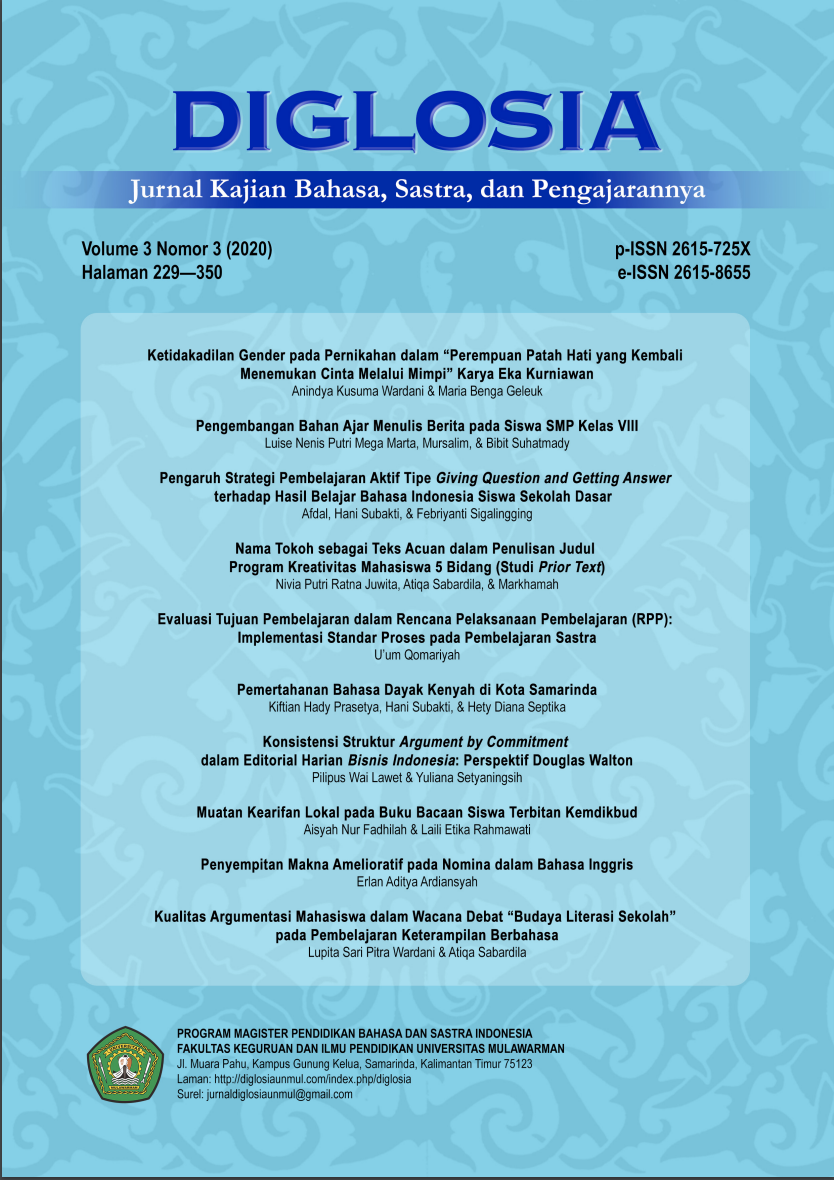Pemertahanan Bahasa Dayak Kenyah di Kota Samarinda Preservation of Dayak Kenyah Language in Samarinda
Main Article Content
Abstract
The focus of the problem in this study is motivated by the phenomenon of the development of the times and the rapid flow of globalization making the Dayak ethnic in Samarinda City specifically, becoming an ethnic minority so language retention needs to be made in multilingual minority language communities. The language that is the focus of research is Dayak Kenyah Language. The purpose of this study was to determine the factors of preservation of Dayak Kenyah Language in Samarinda City. This research uses descriptive qualitative method with a sociolinguistic approach. The research data were written text (conversational transcripts) from the data source of the Dayak Kenyah ethnic community in Samarinda City. Data collection techniques using the stages of observation, Simak Free Engage Involved (SBLC) techniques, and interviews. Research instruments in the form of devices, stationery, notebooks, and indicators of language maintenance. The results of the study found that there were efforts made by the Dayak Kenyah community in Samarinda City as a manifestation of the language of the Dayak Kenyah region. The research findings are: (1) family factors, (2) social factors, (3) communication intensity factors, (4) activity factors, and (5) desire factors in language retention. The conclusion in this study focuses more on the care and contribution of various layers of ethnic Dayak Kenyah communities, especially in Samarinda, towards the regional languages they have.
Downloads
Article Details
![]()
Every work in Diglosia: Jurnal Kajian Bahasa, Sastra, dan Pengajarannya is licensed under a Creative Commons Attribution-ShareAlike 4.0 International License.
Under the following terms:
- Attribution — You must give appropriate credit , provide a link to the license, and indicate if changes were made . You may do so in any reasonable manner, but not in any way that suggests the licensor endorses you or your use.
- ShareAlike — If you remix, transform, or build upon the material, you must distribute your contributions under the same license as the original.
- No additional restrictions — You may not apply legal terms or technological measures that legally restrict others from doing anything the license permits.
Authors who publish with this journal agree to the following terms:
- Authors retain copyright and grant the journal right of first publication with the work simultaneously licensed under a CC BY-SA 4.0 DEED Attribution-ShareAlike 4.0 Internationalthat allows others to share the work with an acknowledgment of the work's authorship and initial publication in this journal.
- Authors are able to enter into separate, additional contractual arrangements for the non-exclusive distribution of the journal's published version of the work (e.g., post it to an institutional repository or publish it in a book), with an acknowledgment of its initial publication in this journal.
- Authors are permitted and encouraged to post their work online (e.g., in institutional repositories or on their website) prior to and during the submission process, as it can lead to productive exchanges, as well as earlier and greater citation of published work.
References
Chaer, A. (2003). Psikolinguistik: Kajian Teoretik. Rineka Cipta.
Ernawati, N., & Usman. (2019). Pergeseran Bahasa Masyarakat Etnis Tionghoa di Bima. Mabasan, 13(1), 31—44. https://mabasan.kemdikbud.go.id/index.php/MABASAN/article/view/246
Istianingrum, R. (2015). Eksistensi Bahasa Dayak Kenyah di Kota Balikpapan Kalimantan Timur. Paramasastra, 2(1). https://journal.unesa.ac.id/index.php/paramasastra/article/view/1505
Nisah, N., Prasetya, K., & Musdolifah, A. (2020). Pemertahanan Bahasa Daerah Suku Bajau Samma di Kelurahan Jenebora Kecamatan Penajam Kabupaten Penajam Paser Utara. Jurnal Basataka (JBT), 3(1), 51—65. https://doi.org/10.36277/basataka.v3i1.86
Prasetya, K. H. (2016). Struktur Gerak dalam Wacana Interaksi Kelas di Kelas X SMA Negeri 5 Malang. Tesis Program Pascasarjana Universitas Negeri Malang.
Prasetya, K. H. (2018). Analisis Percakapan Monolog pada Acara Stand Up Comedy Metro TV. Jurnal Basataka (JBT), 1(1), 11—21. https://doi.org/10.36277/basataka.v1i1.17
Sugiyono. (2016). Penelitian Kuantitatif, Kualitatif, dan R&D. Bandung: Alfabeta.
Sumarsono. (2006). Sosiolinguistik. Yogyakarta: Pustaka Pelajar.
Tondo, H. (2009). Kepunahan Bahasa-Bahasa Daerah: Faktor Penyebab dan Implikasi Etnolinguistis. Jurnal Masyarakat dan Budaya, 11(2), 277–96.

